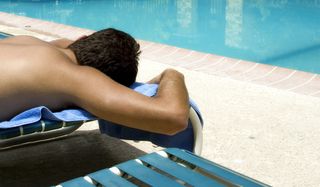UV Exposure May Be Less Damaging in the Morning, Study Finds

Exposure to ultraviolet (UV) radiation in the morning may be less harmful to your skin than tanning in the afternoon, new research suggests.
Mice exposed to UV radiation shortly after they awoke had fewer skin tumors than those exposed to the same level of radiation during other times of day, the study showed.
The skin's ability to repair itself rises and falls with our circadian rhythms — the body's internal clock, the study showed.
"The amount of tumors was fivefold higher in mice that were exposed to UV radiation" near their bedtime, said Dr. Aziz Sancar, of the University of North Carolina School of Medicine, who led the research. He hypothesized that in humans, exposure to UV radiation in the evening would also lead to an increase in skin cancer risk; exposure in the morning would be safer, he said.
The new findings were published today (Sept. 23) in the journal Proceedings of the National Academy of Sciences.
DNA fix-it protein
UV radiation, a component of sunlight which is also emitted by the bulbs in tanning beds, damages the DNA of skin cells. Over time, this can lead to skin cancer.
Sign up for the Live Science daily newsletter now
Get the world’s most fascinating discoveries delivered straight to your inbox.
Most organisms have a 24-hour clock that partly governs when body processes take place, and in earlier work, Sancar found that XPA, a protein in humans and mice that fixes damaged DNA, follows the circadian rhythm.
Levels of XPA are highest shortly after an organism awakes, which is in the evening for mice and the morning for humans. And when XPA levels are high, the protein can fix errors in DNA that are caused by UV radiation. When XPA is low — for humans, during the evening—these errors go unrepaired, heightening cancer risk.
To test whether the findings of XPA levels had real implications for skin cancer risk, Sancar and his colleagues exposed mice to high levels of UV radiation at either 4 a.m. or 4 p.m. for 25 weeks. The mice that were exposed in the morning hours, when XPA is lowest, developed five times as many tumors. Moreover, the tumors were more often invasive, meaning they were a more advanced stage of skin cancer.
"The takeaway message is that, for humans, the morning hours are safer for exposure to sunlight and tanning booths than the afternoon hours," Sancar said. "But I don't want people to take the message from this that if you go tan in the morning, you'll be fine. The mice developed skin cancer in both groups."
Cycle of the sun
"The differences seen are quite remarkable," said Philip Hanawalt of Stanford University, a biologist who in the 1960s discovered the process of DNA repair in which XPA plays a role. "The results are most certainly applicable to humans," he told MyHealthNewsDaily.
"Further studies will undoubtedly confirm the basic findings, and it is likely that the findings may have an impact upon sunbathing behavior and a reduction of skin cancer incidence in humans," Hanawalt said.
However, Hanawalt said, researchers must further study how differences in UV radiation in sunlight throughout the day affect cancer risk. In the study, the UV exposure was identical at all times, but on a beach with natural sunlight, the level of UV radiation varies.
Sancar said he is planning future studies on human skin cells to study how XPA levels vary in humans, and how this might play a role in cancer risk.
Pass it on: Tanning in the morning may increase one's risk of skin cancer less than tanning in the afternoon.
This story was provided by MyHealthNewsDaily, a sister site to LiveScience. Follow MyHealthNewsDaily on Twitter @MyHealth_MHND. Find us on Facebook.
